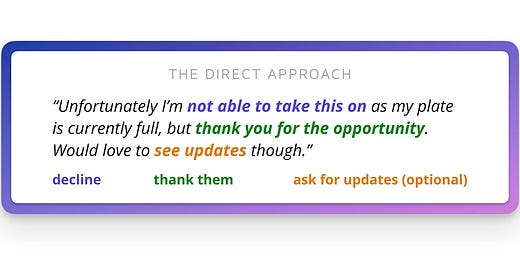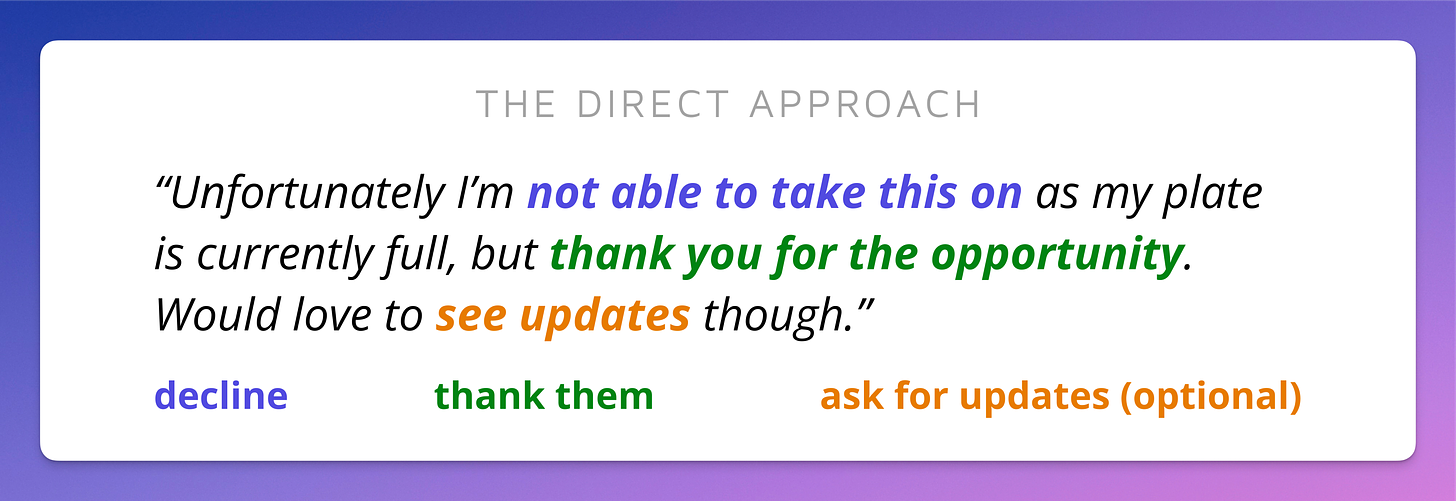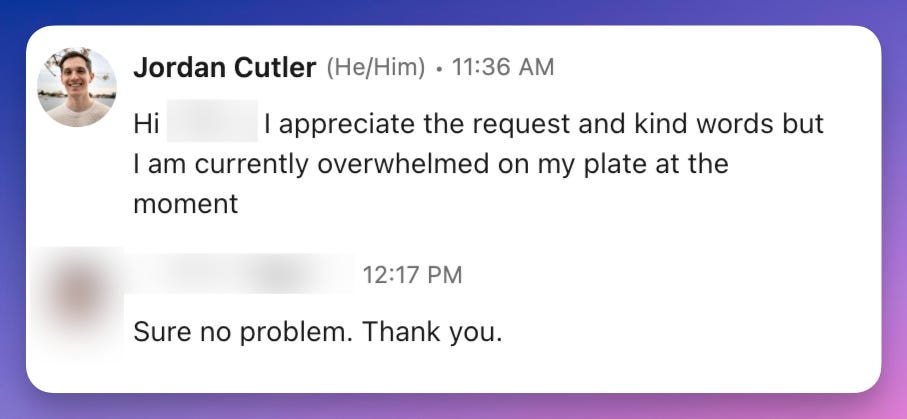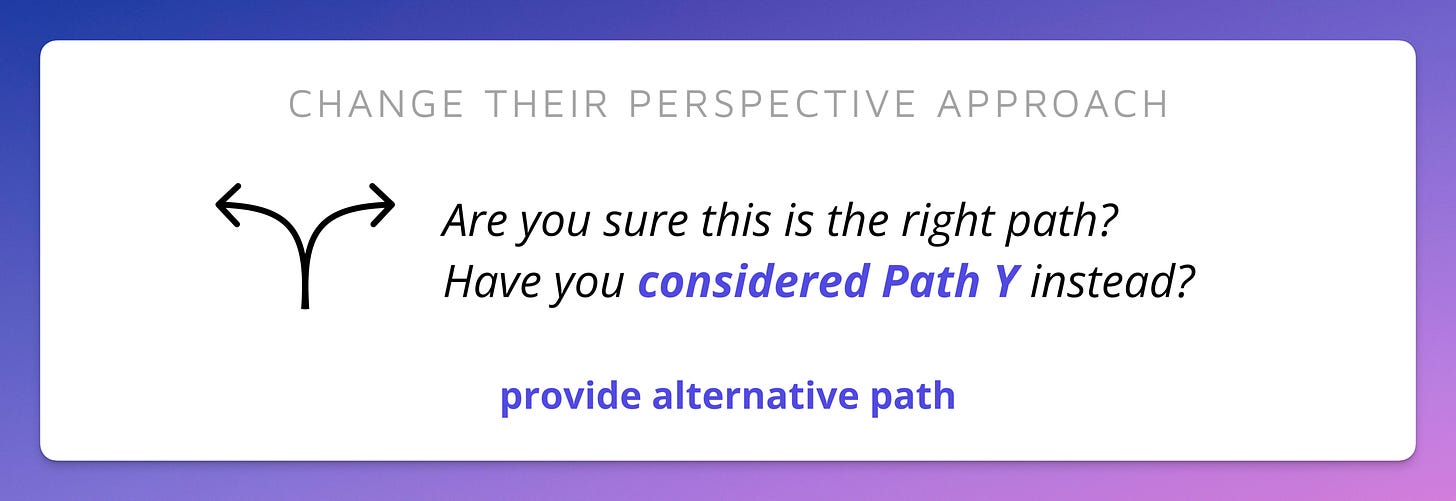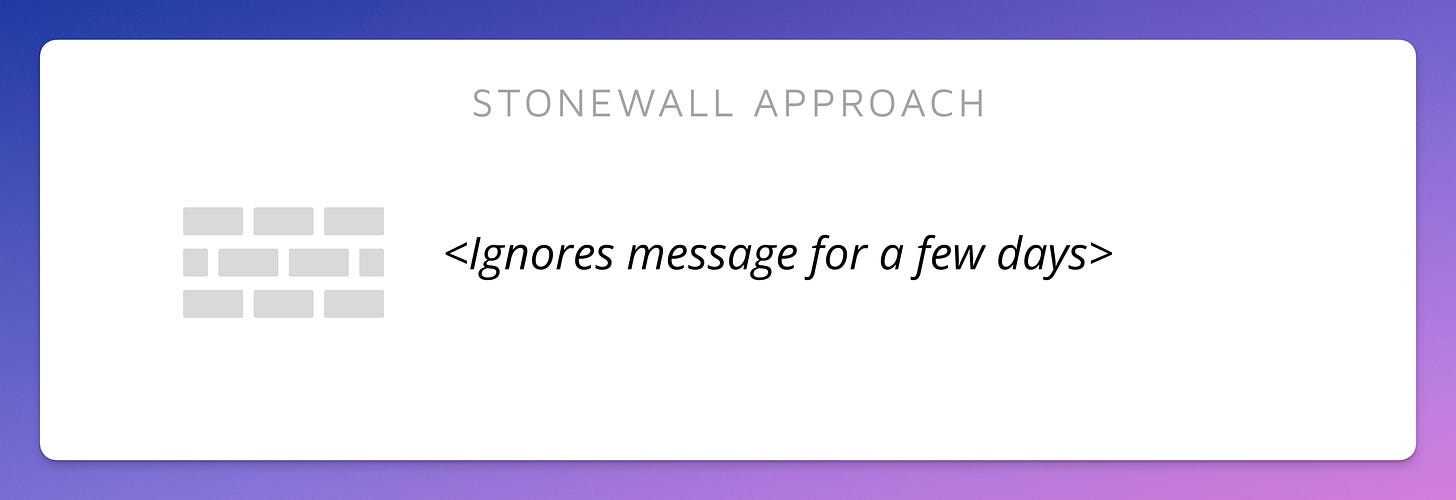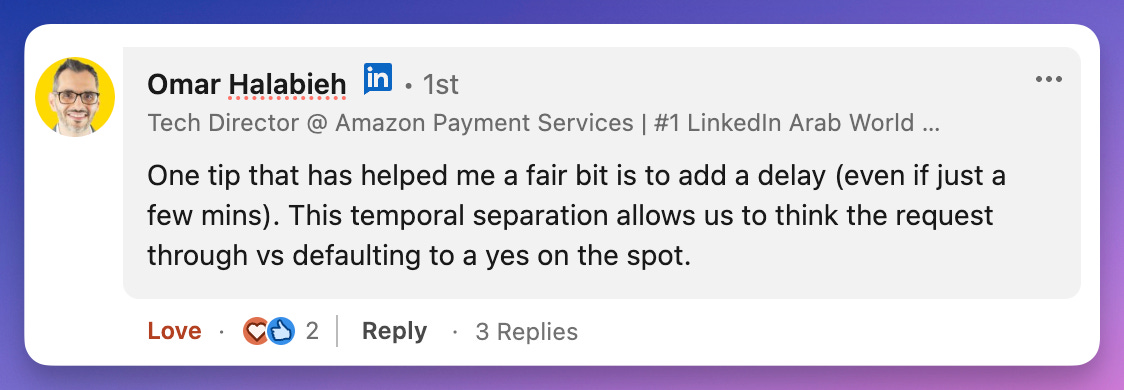How to say "No" and win back your time as a software engineer
Guest post by Meta Staff Engineer, Sidwyn Koh
Hi fellow High Growth Engineer, Jordan here 👋
As part of the month of collaborations, I’m excited to feature Sidwyn Koh. As a Staff Engineer at Meta, Sidwyn has to ruthlessly prioritize the most impactful and relevant work. At the same time, there are constant stakeholders pulling for his time and attention.
Because of that, he had to learn the most effective ways to say no politely. And today, he’s going to share those with you!
So without further ado, I’ll pass the mic 🎤 to Sidwyn 👏
The most senior engineers I have come across possess a common skill: Saying no.
As software engineers, we’re often asked to take on many responsibilities in addition to writing code. We have to scope projects, go to meetings, and help others out. But by doing too much, we lose our focus.
To be impactful, we have to focus. We have to say no. Let’s see how.
👌 It’s Okay to Say No
First, it’s okay to say “No.” There are ways to avoid coming off as rude. If you’re at a mid-level and above, your time becomes more important as you gain more autonomy.
You should say “No” when:
You need focus time
It’s not what you’re good at
It prevents you from reaching your own goals
You’re not returning a favor
These are the rules I use, but they’re not exhaustive. You may have other reasons to say “No.”
📣 Shopify (Sponsor)
Quick aside to thank Shopify for kindly sponsoring this week’s newsletter 🙏
Shopify gives you all the tools you need to start, manage, and grow an online business. It’s essentially your own personal business partner.
If you want to start an online business, I recommend checking out Shopify and their new Summer '24 Edition, which features 150+ updates helping developers like you.
✋ How to Say No
Here are four practical approaches to saying No.
The Direct Approach
The Redirect Approach
Change Their Perspective Approach
Stonewall Approach
Let’s explore each approach in detail. You’ll learn the exact phrases to use and when to use them based on real examples from my experience.
(1) The Direct Approach
The direct approach is my favorite and most common approach to saying No.
It has three parts:
Politely decline
Thank them for considering you
Express interest
Here’s how it looks in practice:
Say this: “Unfortunately I’m not able to take this on as my plate is currently full, but thank you for the opportunity. Would love to see updates though.”
When to use this: Almost all the time. It’s the simplest and most direct approach to answer someone when they ask you for help.
Why use this: It’s concise and transparent. Everyone understands what a full plate looks like. You don’t have to further clarify what’s on your plate.
How to use it correctly:
Be polite while declining.
Don’t explain what’s on your plate. It’s irrelevant to the request.
Express interest in the other person’s project. This is useful for not coming across as rude.
Real Life Example:
Them: “Hey, I’m working on Project Jupiter, and I could use your help with this part of the project. What do you think?”
You: “Wow, thanks for considering me. Unfortunately, I’m not able to. My plate is completely full, but thanks for thinking of me. I’d love to keep up with how it progresses though. Any way for me to stay in the loop?”
Here’s a recent real-life example from Jordan using this exact method:
That’s it! Straightforward and easy.
(2) The Redirect Approach
Another way to say “No” is to redirect to someone else who’s better suited to answer the question.
Say this: “Thanks for sharing this opportunity. However, I believe Jenny might be the best person for this since she has a ton of experience in this area. Have you already asked her?”
When to use this: Use this when someone else is better equipped to tackle their issue.
Why use this: This approach helps both parties. The requester can find someone better, and you can politely decline.
How to use it correctly:
Make sure you know the right person in mind
Give the suggested person a heads-up
Suggest one or two names, but not more than two
Show genuine interest and ask for updates
Real Life Example:
Them: “Argh! I’m currently facing a bunch of issues with this tool. Do you think you can help me out?”
You: “I’m actually not the best person to tackle this. Have you reached out to Lucas? I had a chat with him last week and he understood this piece of data really well. I can give him a heads up if you’d like.”
(3) Change Their Perspective Approach
My next approach is counter-intuitive, but it’s worked great for me. It’s called changing their perspective.
Say this: “I know this might be different from what you’re asking, but have you considered trying this <insert path> instead?”
After you ask this, ensure they drive the resolution independently.
When to use this: When you know that a better way to approach this exists.
Why use this: You have some experience in this area. And you know that they are not approaching the problem correctly. You can provide them a new perspective.
How to use it correctly:
Use this when you’re confident with your proposal
Provide general direction when guiding them
Do not promise to help all the way
Real Life Example:
Them: “I was thinking of using data analysis with the Jonah Tool to find out how many users are performing this particular click action. Can you help me out?”
You: “Are you sure this is the right path to take? Have you considered other approaches, like using our Analysis Tool B? I’ve done that before and can point you to the right documentation.”
(4) The Stonewall Approach
This is my least favorite approach, but it’s needed when the other approaches don’t work. This approach should be your last resort.
Say this: Say nothing at all. Leave them on read.
When to use this: Use this when the other party is continuously begging you for favors, or if you’re dealing with too much.
Why use this: This is the best way to handle an extreme number of requests.
How to use it correctly:
Use this only as a last resort
Ensure your manager knows your bandwidth and can back you up
Considering scaling up your bandwidth through async methods, like wikis and notes
Real Life Example:
Them: “Hey Sidwyn, could you help me with this problem?”
You: Reads and ignores the message.
Disclaimer: I have used this method several times, especially on days that get extremely busy. Of the hundreds of times I’ve used this, it has gone wrong once. The requester ended up reporting to my manager that I was unresponsive. In this case, I explained to my manager that I had a full day of meetings and I couldn’t respond promptly.
If you want, you can also take a day or two to respond. You can say, “So sorry I missed this. The last couple of days have been hectic. Are you still working through this?". From experience, by that time, they’ve already figured it out.
Omar Halabieh, Tech Director at Amazon does something similar where instead of responding instantly, he gives himself a brief period of time to decide a “yes” or “no.”
Again, use the stonewall technique as a last resort when you’re either overwhelmed or have been pestered too often for a favor.
💡 Other Useful Tips
Communicate Boundaries: On Mondays, post your priorities for the week on your internal board. If you don’t have one, share it in your weekly standup. Be clear on your responsibilities and what others should expect from you this week.
Involve your manager if needed: If you’re feeling overwhelmed, make sure your manager can back you up. They help you rank your priorities and serve as the first line of defense in case someone reports you. They’re your champion.
Set up focus blocks: Create focus blocks that no one can book over. Better yet if it can auto-decline meetings. If you use Slack, some calendar integrations will auto-update your status based on your calendar.
Scale yourself: If others often seek you out as an expert, scale yourself by documenting & sharing your knowledge. This way, you can point others to the resource you created.
Manage your reputation: You shouldn’t say “No” every time. Yet, if you repeatedly agree to every ask, you’ll become the team’s go-to problem solver. You should strike a balance here. Help others out when you can, but also decline plenty of opportunities.
Saying “No” is never easy. But it will lead to a more balanced and fulfilling career. And greater impact at work.
📖 TL;DR
It’s okay to say No. Say No when you need focus time. You won’t come off as rude if you phrase it right.
There are four approaches to saying No:
Direct: Thank, decline, and express interest.
Redirect: Refer to someone else who is better suited for the ask
Change Their Perspective: Is this ask phrased correctly? Does it really need me?
Stonewall: Ignore, and follow up a few days later.
Other relevant tips:
Communicate boundaries to be clear on expectations
Involve your manager if needed
Set up focus blocks so no one can bother you
Scale yourself through notes and wikis
Manage your reputation carefully – say “No” often but “Yes” sometimes!
🙏 Thank you to Sidwyn
Thank you to Sidwyn Koh for his insights on an important topic for getting back our time and focusing on what matters most. If you’d like to learn more from him, follow him on LinkedIn and check out his Substack,
.👏 Shout-outs of the week
- on — Concise post on why measuring dev productivity via data doesn’t work
- on — A must-read for any engineer. Wes’s articles are too good that I can’t stop shouting her out 😂
Finally, HackerPulse Dispatch allows you to connect your LinkedIn, GitHub, and StackOverflow accounts into a single, common profile perfect for job applications and networking. They’ve kindly sponsored this newsletter. To see a sample, see the profile I created for myself in less than 2 minutes.
Thank you for your continued support and the growth to 70k+ subscribers this week 🙏
P.S. Here are some other things that may interest you:
My LinkedIn: I write daily, actionable tips to become a better developer
My digital products: Get 100+ actionable insights and 50+ phrases used by the best leaders
Newsletter sponsorships: Feature your product to growth-minded engineers and leaders!
You can also hit the like ❤️ button at the bottom of this email to help support me or share this with a friend to get referral rewards. It helps me a ton!
Finally, leaving a review gives you a chance to “Spin the wheel” for rewards 🎁

